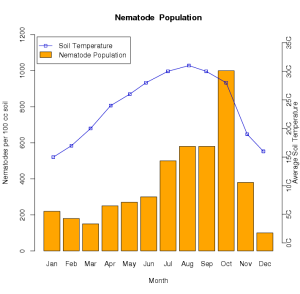Nematode population dynamics
"...if all the matter in the universe except the nematodes were swept away, our world would still be dimly recognizable...we would find its mountains, hills, valleys, rivers, lakes, and oceans represented by a film of nematodes" N.A. Cobb, 1914

Turf damage caused by sting nematodes,
Belonolaimus longicaudatus to golf course turf and sting nematode as inset. Turf damage photo courtesy of Megan Kenelly,
B. longicaudatus image courtesy Tim Todd, Dept. of Plant Pathology, Kansas State University, Manhattan, KS.
Nematodes are the most numerous multicellular worms found on earth. While most nematodes are not parasitic, some are parasites of insects, plants or animals and so can cause disease and important crop losses. Plant pathogenic nematodes cause mechanical damage by penetrating and moving through the plant tissues, cellular changes, cell necrosis, changes in cell growth, and physiological changes in hosts. These injuries disrupt the uptake and flow of water and nutrients in the plant and create openings for entry of other microorganisms. Nematodes may also interact with other pathogens, act as pathogen vectors, and increase susceptibility to environmental stress (Agrios, 2004).
In general, a nematode's life cycle is comprised of six stages, with an egg stage, four juvenile or larval stages, and the adult stage. The juvenile stages do not have reproductive organs, while the adult stage is sexually mature and possesses a complete reproductive system. Nematodes are poikilothermic, cold-blooded, thus their metabolic rate varies according to the temperature of their environment.
Eliminating nematodes is extremely difficult once they are introduced to a field. The best management strategy is to keep plants in good health by managing soil fertility, pH, and moisture. Controlling other pests, diseases and weeds can also help. Observing sanitary practices reduces the risk of spreading nematodes to new non-infested areas. Dispersal of nematodes is primarily through: running water (rain or irrigation run-off), and the movement of human beings, farm equipment, soil debris, and plant material contaminated by nematodes, cysts, or eggs. If resistant crop varieties are available they can help to reduce population increase and similarly crop rotations can reduce feeding and reproduction. Nematicides are most commonly used in high value crops such as strawberries, but they are also frequently used in potato, cotton and sugar beet production.
Sting nematodes, the most damaging of the genus
Belonolaimus, are linked to chlorosis and death of turf grass as well as many other plant species (Crow and Han 2005). Bekal and Becker (2000) monitored population densities of
Belonolaimus longicaudatus at monthly intervals at three different golf courses. Infestations were associated with favorable environmental conditions including warm, sandy soil, and frequent irrigation. Information about population dynamics can guide nematode management. Samples of
B. longicaudatus were collected at location 'TM' at 0 to 15 cm of soil depth, and at locations 'AE' and 'DI' at 0 to 15 and 15 to 30 cm.
The sting nematode population dynamics were similar at the three locations and population sizes were correlated with soil temperature. During 1993 to 1994, the highest population density at location 'TM' occurred in October, with approximately 1,000 nematodes per 100cc of soil.
The following example illustrates the relationship between soil temperature and nematode populations, as well as some techniques for assembling graphics with multiple series in R.
## Set up the vector of nematode populations
npop
<-
c(220,180,150,250,270,300,500,580,580,1000,380,100)
## Set up vector of associated months
names(npop)
<-c (
"Jan",
"Feb",
"Mar",
"Apr",
"May",
"Jun",
"Jul",
"Aug",
"Sep",
"Oct",
"Nov",
"Dec"
)
## Set up the bar plots of the nematode populations,
try help(barplot) for more information
barplot(
npop,
axes=FALSE,
main="Nematode Population",
ylim=c(0,1200),
col="orange",
xlab="Month",
ylab="Nematodes per 100 cc soil")
axis(2,seq(0,1200,by=200)
)
## Set up the new plot to be drawn on top of the barplot,
try help(par) for more information
par(new=T)
# This sets the average monthly temperature
# for the line above the population
y
<-c (15,17,20,24,26,28,30,31,30,28,19,16)
# This positions the points on the X axis
# correctly in the middle over the top of the bar chart.
y2
<-c (0.5,1.45,2.45,3.5,4.5,5.35,6.5,7.6,8.5,9.55,10.65,11.5)
## Plot the temperature points
plot(
y2,
y,
ylim=c(0,35),
xlab=NA,
ylab=NA,
xlim=c(0,12),
axes=FALSE,
type="o",
pch=22,
col="mediumblue"
)
axis(
4,
seq(0,35,by=5),
labels=FALSE
)
## Lay out the points for temperature
points(
y2,
y,
pch=22,
col="mediumblue"
)
## Label the right axis, try help(mtext) for more information
mtext(
c("0C","5C","10C","15C","20C","25C","30C","35C"),
4,
at=seq(0,35,by=5),
line=.25
)
## Label the right axis, try search(mtext) for more information
mtext(
"Average Soil Temperature",
4,
line=1,
cex=1
)
## Create a legend
legend(
"topleft",
c("Soil Temperature","Nematode Population"),
pch=c(22,NA),
lty=c(1,NA),
col=c("mediumblue",NA),
inset=0.01
)
## Create an orange rectangle next to
the Nematode Population label for the legend
rect(-0.2,32.4,0.4,33.4,col="orange")
Output

Here the graphic generated in R shows the nematode population trend plotted along with soil temperature.
Further analysis of this type of data might include a time series analysis that would take into account both potential temporal autocorrelation and temperature.
Next, an introduction to disease progress curves and AUDPC
